Explorers aboard the E/V Nautilus successfully performed the first deep-water visual dive to revisit the Imperial Japanese Navy ship, Akagi, in a momentous occasion for marine archaeology and world history. A Japanese and American-led expedition team saw the debris for the first time since it sank to the deep ocean seafloor 81 years ago at a depth of 18,000 feet (5.5 kilometers). They conducted the first visual inspection of the wreckage.
The first look at the WWII Vessel Akagi.
The Akagi, or 赤城 in Japanese, was regarded as the Japanese naval fleet's flagship at the time. The Battle of Midway, which took place close to the U.S. Hawaiian Islands, was won or lost as a result of the bombing of that ship and the subsequent sinking by American forces.
A dive was made by a group of deep-sea explorers and researchers using an autonomous underwater vehicle (AUV) with sonar. The long-lost Akagi aircraft carrier was later discovered, for the first time since it sank, at 18,000 feet of water in the Papahnaumokukea Marine National Monument (PMNM), some 1,300 miles (2,092 kilometers) northwest of Pearl Harbor.
Remote-operated vehicles (ROVs) were used by Nautilus researchers to descend to the seafloor in 2023, nearly four years later. It is the first time since its sinking in 1942 that people have actually seen the wreckage.
It was successful.
The study team, which included archaeologists from Japan and the U.S., carried out the historic, non-invasive dive in September 2023 to record the wreck's historical significance, assess its condition, and pay tribute to the victims lost on both sides of the conflict.
"As we are indeed on the carrier Akagi, let’s take a moment of silence, please, to remember the type of site that we are on – an important site – for great service and sacrifice and the loss of lives," mentioned James Delgado, an archaeologist associated with the expedition.
Surveying the Akagi and the other ships destroyed in the Battle of Midway has proven to be a difficult undertaking because to its distant location and exceptional depth. The Akagi marks one of the deepest, most remote cemeteries in the world with its dark, icy, high-pressure waters of the deep Pacific Ocean.
"We can understand this as Native Hawaiians and the depth and the reverence that we hold for this place, and for those who lay in the realm of Po Kanaloa, the god of the sea," said Malia Evans, a monument resource monitor at the O’ahu Education Coordinator PMNM. "We are in reverence as we view the Akagi."
Battle damage, including a section of the carrier's deck that had been turned upside down due to accumulated explosive pressure, was visible from the ROV cameras.
"The survival of this structure, even in its damaged state, is something we hadn’t been expecting. It’s rather amazing to see and even though it has deteriorated and fallen in, there are identifiable elements that clearly connect us back to that time and that point in the battle," said Delgado.
The battle of Midway, which lasted four days, saw the sinking of four Japanese carriers, including the Akagi. It began on June 4, 1942, after American intelligence agents gathered information from Japanese communications revealing the imperial navy's plans to set up a defensive perimeter of islands, including the remote Midway Atoll.
Both Japanese and American forces viewed Midway, a shallow reef halfway between Honolulu, Hawaii, and Tokyo, Japan, as a key location for establishing a military base. Nearly 3,400 sailors and airmen were lost at the Battle of Midway, which marked a change in military dominance between Japan and the United States in the Pacific War theater.
"It was a tough four days 81 years ago. A lot of pain, a lot of sorrow, and we hope that some healing has happened to so many men and women that were involved," said Delgado. "From the study of these sites, a lot of good can come and we’ve already seen that with the collaboration of people coming together."
Because it altered "the balance for the Pacific War, and with that, the future of the Pacific," the Battle of Midway is now regarded as one of the "ten most significant naval battles in human history," according to Delgado.
"Overall, the Battle of Midway claimed the lives of nearly 3,400 sailors and airmen with US losses in excess of 350 and Japanese losses in excess of 3,000. Five major aircraft carriers (Akagi, Kaga, Sōryū, Hiryū, and Yorktown), as well two other surface units (heavy cruiser Mikuma and the destroyer USS Hammann), and over 390 aircraft were also destroyed," wrote the Ocean Exploration Trust, a nonprofit that oversees operations of the exploration vessel and is headed by Robert Ballard, who found the Titanic in 1985.
The naval battleground is currently protected by PMNM, one of the world's largest maritime protected areas and a UNESCO World Heritage Site.







